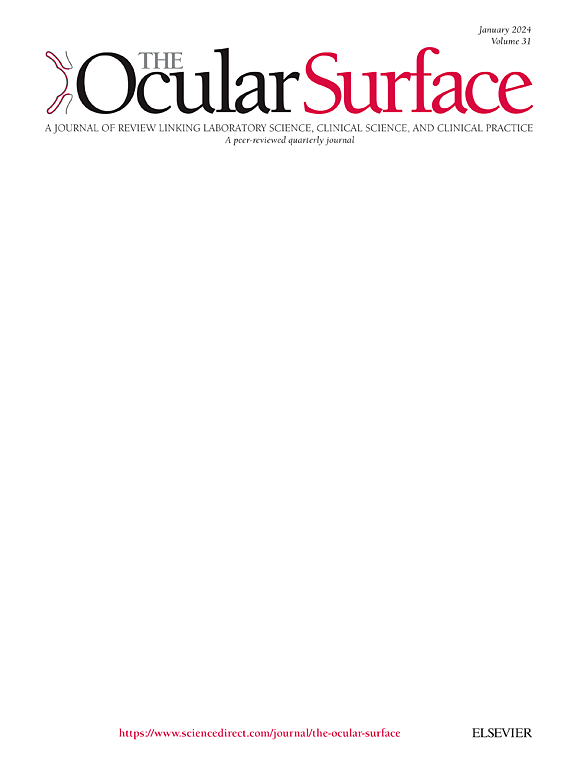Acanthamoeba keratitis treatment outcomes compared for drug delivery by protocol versus physician's individualised treatment
IF 5.6
1区 医学
Q1 OPHTHALMOLOGY
引用次数: 0
Abstract
Purpose
To compare Acanthamoeba keratitis (AK) outcomes for treatment delivered using a detailed protocol versus physician's individualised treatment.
Methods
This double cohort study compared the outcomes of these different delivery methods for PHMB 0.02 % and diamidine 0.1 % dual therapy. The primary outcome was the medical cure rate without surgery within 12 months (MCR_12) and the secondary was visual acuity. Any change of treatment, any surgery, or treatment for >12 months was a failure. Outcomes were both unadjusted and adjusted, using multivariable analysis, for baseline differences affecting outcomes. Patients were from two centres in Milan and London treated at different times; the individualised cohort (1991–2012) and per-protocol cohort (2017–2021).
Results
The individualised cohort included 96 and the per-protocol 47 patients. Both unadjusted and adjusted results were similar. The unadjusted outcomes for both centres combined showed significantly improved outcomes for per-protocol treatment with a 1.59-fold improvement in MCR_12 (95 % CI 1.40–1.80, p < 0.001) and a 2.1-fold increase in visual acuity ≥20/25 (95 % CI 1.34–3.29, p < 0.001). Amongst potential confounding factors examined, neither baseline AK disease stage, treatment centre nor the type of diamidine significantly influenced outcomes.
Conclusions
This study shows significant advantages for the use of protocol delivered versus individualised treatment for AK. The use of evidence-based treatment delivery protocols, like the one used here for AK, might improve outcomes for all causes of microbial keratitis and could offer practitioners and patients the benefit of having an easy-to-follow drug delivery protocol, with known outcomes.
棘阿米巴角膜炎的治疗结果比较方案给药与医生个体化治疗。
目的:比较棘阿米巴角膜炎(AK)的治疗结果提供了一个详细的方案和医生的个体化治疗。方法:本双队列研究比较了0.02% PHMB和0.1%二胺双重治疗的不同给药方式的结果。主要观察指标为12个月内不手术治愈率(MCR_12),次要观察指标为视力。任何治疗方法的改变,任何手术,或长达12个月的治疗都是失败的。采用多变量分析,对影响结果的基线差异进行了未调整和调整。来自米兰和伦敦两个中心的患者在不同时间接受治疗;个体化队列(1991-2012)和按方案队列(2017-2021)。结果:个体化队列96例,按方案47例。未调整和调整后的结果相似。两个中心未经调整的合并结果显示,按方案治疗的结果显著改善,MCR_12改善1.59倍(95% CI 1.40 - 1.80, p < 0.001),视力≥20/25增加2.1倍(95% CI 1.34 - 3.29, p < 0.001)。在检查的潜在混杂因素中,基线AK疾病分期、治疗中心和二胺类型均未显著影响结果。结论:这项研究显示了使用方案传递与个性化治疗AK的显著优势。使用循证治疗方案,如这里使用的AK,可能会改善所有原因的微生物角膜炎的结果,并可以为医生和患者提供一个易于遵循的药物给药方案,已知的结果。
本文章由计算机程序翻译,如有差异,请以英文原文为准。
求助全文
约1分钟内获得全文
求助全文
来源期刊

Ocular Surface
医学-眼科学
CiteScore
11.60
自引率
14.10%
发文量
97
审稿时长
39 days
期刊介绍:
The Ocular Surface, a quarterly, a peer-reviewed journal, is an authoritative resource that integrates and interprets major findings in diverse fields related to the ocular surface, including ophthalmology, optometry, genetics, molecular biology, pharmacology, immunology, infectious disease, and epidemiology. Its critical review articles cover the most current knowledge on medical and surgical management of ocular surface pathology, new understandings of ocular surface physiology, the meaning of recent discoveries on how the ocular surface responds to injury and disease, and updates on drug and device development. The journal also publishes select original research reports and articles describing cutting-edge techniques and technology in the field.
Benefits to authors
We also provide many author benefits, such as free PDFs, a liberal copyright policy, special discounts on Elsevier publications and much more. Please click here for more information on our author services.
Please see our Guide for Authors for information on article submission. If you require any further information or help, please visit our Support Center
 求助内容:
求助内容: 应助结果提醒方式:
应助结果提醒方式:


